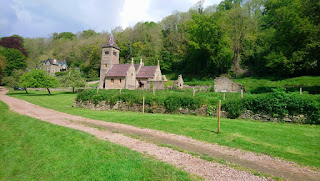King Arthur and his Knights by Sir James Knowles
‘These tales of the
legendary king and his knights of the Round Table form a highly readable
abridgment of Thomas Malory's classic Le Morte d'Arthur. Beloved fables of
Arthur, Merlin, Guinevere, Galahad, Lancelot, and other denizens of Camelot.’
Taken from the Amazon web page promoting the book.
Is the statement describing
Knowles’s book available on Amazon. He wrote the book in 1895 as an easier,
more updated version of Thomas Malory’s Morte D’Arthur. I chose this book to
read first as I had perused Malory’s book and found it to be interesting but
potentially challenging as it was written in a hybrid of Middle English and
Early modern English. I reasoned that a book written in the late nineteenth
century would be a gateway to a possibly harder to decipher older text.
Indeed some of the language
used is more modern however, the text is littered with lots of examples of
archaic language such as Anon. I found it quite interesting discovering older
words which are no longer used and finding out what they meant. As a source
material for the legends of King Arthur it doesn't deviate too much from
Malory’s version. The Knights are the superheroes of the Medieval world with
their own chivalric code of honour they aspire to adhere too. In some ways I
enjoy reading a slightly updated version of a Medieval text as it gives me an
insight to views held in the past. Of course historians and literary experts
would be eager to point out that most of these texts were produced as
entertainment in the courts of Europe and therefore do not necessarily
encompass the world view of many people who were living at this time. The world
it portrays is a world of Patriarchy: powerful men, Damsels needing rescuing
and any women of power are either the cause of the Male protagonist’s downfall
or outright evil. This is a worldview which reflects the preoccupations of the
ruling class of the time. It’s a shame the voice of the masses is absent mainly
down to the levels of illiteracy prevalent in the era. It does however, give
us, the modern reader an insight into how the elites of Western Europe viewed
themselves and an insight into their aspirations.
These tales are based on
old books constructed for entertainment in courts and not intended as a novel
for the modern reader. Therefore the book can appear problematic for the modern
reader: none of the characters seem to have an arc where they seem to grow. We
don't get the perspective of the characters and there is a tendency to describe
actions almost in a list like manner. The characters have a series of battles
where they smote each other. There isn’t any perspective or feelings invested
in the characters and than can make it hard reading for people raised in the
conventions of a literary tradition that has developed since Malory first wrote
his version of the legends of King Arthur based on the earlier medieval
scripts. Sir James Knowles surprisingly, considering he was writing in the very
late nineteenth century, doesn’t add more plot or perspectives from the
characters more engaging and sympathetic. Moreover, the female characters are
problematic and therefore could potentially alienate large sections of a modern
audience.
I’m still only half way
through the book and find myself reading novels in between reading chunks of
this novel which may give you an indication of the accessibility of this book.
Still I’m determined to finish the book and adapt my review of it.

Comments